Introduction
The rapid evolution of software development presents significant challenges for developers, especially when it comes to ensuring that various components work seamlessly together. As they navigate increasingly complex APIs and the necessity for robust documentation, the importance of effective code integration testing cannot be overstated.
So, how can developers tackle these hurdles? Enter Kodezi, a platform designed to address these very challenges. With features that streamline workflows and enhance collaboration, Kodezi empowers teams to improve their integration testing processes.
Imagine a world where your coding practices are not just efficient but also elevate the quality of your code. By leveraging Kodezi's innovative tools, teams can boost productivity and ensure that their projects run smoothly.
But with so many options available, how can organizations identify the most effective strategies to implement? Explore the tools available on Kodezi and discover how they can transform your integration testing experience.
Kodezi | Professional OpenAPI Specification Generator - AI Dev-Tool: Automate Your Code Integration Testing
Coding challenges can be daunting for developers. With the increasing complexity of APIs, ensuring seamless connectivity and accurate documentation is crucial. This is where Kodezi steps in as a professional OpenAPI specification creator, automating code connectivity evaluation and becoming an essential tool for B2B engineering teams.
By leveraging AI code integration testing, Kodezi CLI simplifies the process of generating and maintaining API documentation. It ensures that your AI code integration testing is always aligned with the latest code changes. This automation not only saves time but also reduces the risk of human error. As a result, programming productivity is enhanced, and code quality improves before production.
The automation evaluation market is projected to reach a staggering $68 billion by 2025. This highlights the growing importance of tools like Kodezi. Furthermore, Kodezi's suite of developer tools, which includes automated code reviews and seamless synchronization of API documentation, underscores the trend towards AI code integration testing in the industry.
Real-world instances of OpenAPI specification generators in development teams illustrate Kodezi's practical use. These examples reinforce its value in achieving streamlined and precise evaluation processes. Why not explore the tools available on the Kodezi platform and see how they can transform your coding practices?

Understanding Integration Testing: Core Objectives and Importance
Integration evaluation is crucial for developers facing the challenges of ensuring that various software components work together seamlessly. Have you ever encountered issues where different modules just don’t communicate as they should? This is where effective integration evaluation comes into play. It helps identify interface defects, validates data flow between modules, and confirms that all components operate correctly within a unified environment.
Furthermore, AI code integration testing is vital for the early detection of issues, which can significantly reduce both the cost and complexity of addressing problems later in the development cycle. Recent studies indicate that organizations adopting early combined assessments can achieve cost savings of up to 24%. By detecting and addressing flaws before they escalate, teams can streamline their development efforts.
In addition, effective incorporation assessment strategies often include AI code integration testing as part of automated evaluation frameworks. These frameworks enable continuous integration and deployment, allowing teams to maintain high-quality standards while accelerating development cycles. For instance, companies that implemented automated assessment procedures reported a 30% boost in efficiency. Isn’t it impressive how strong evaluation practices can transform workflows?
By emphasizing collaborative assessments, teams can enhance cooperation, simplify workflows, and ultimately deliver more reliable software solutions. So, are you ready to explore how integrating robust evaluation strategies can elevate your development process?

Challenges in Integration Testing: Identifying Common Pitfalls
Coding challenges can often feel overwhelming for developers. Frequent mistakes in combining systems, such as insufficient coverage of assessments and ignoring edge scenarios, can lead to significant setbacks. Moreover, environmental variations are often neglected, complicating the development process.
In addition, teams frequently encounter issues with unreliable tests that yield inconsistent results, which can undermine trust in the outcomes. Have you ever faced misunderstandings among team members due to ineffective communication? This can lead to overlooked defects and further complications in your projects.
Tackling these challenges requires a proactive approach to evaluation and collaboration. Kodezi offers specific features designed to address these pain points, enhancing productivity and code quality. By utilizing Kodezi, developers can streamline their processes and ensure more reliable outcomes.
Imagine the benefits of improved communication and clearer assessments. With Kodezi, you can foster a collaborative environment that minimizes errors and maximizes efficiency. Why not explore the tools available on the platform and see how they can transform your coding practices?
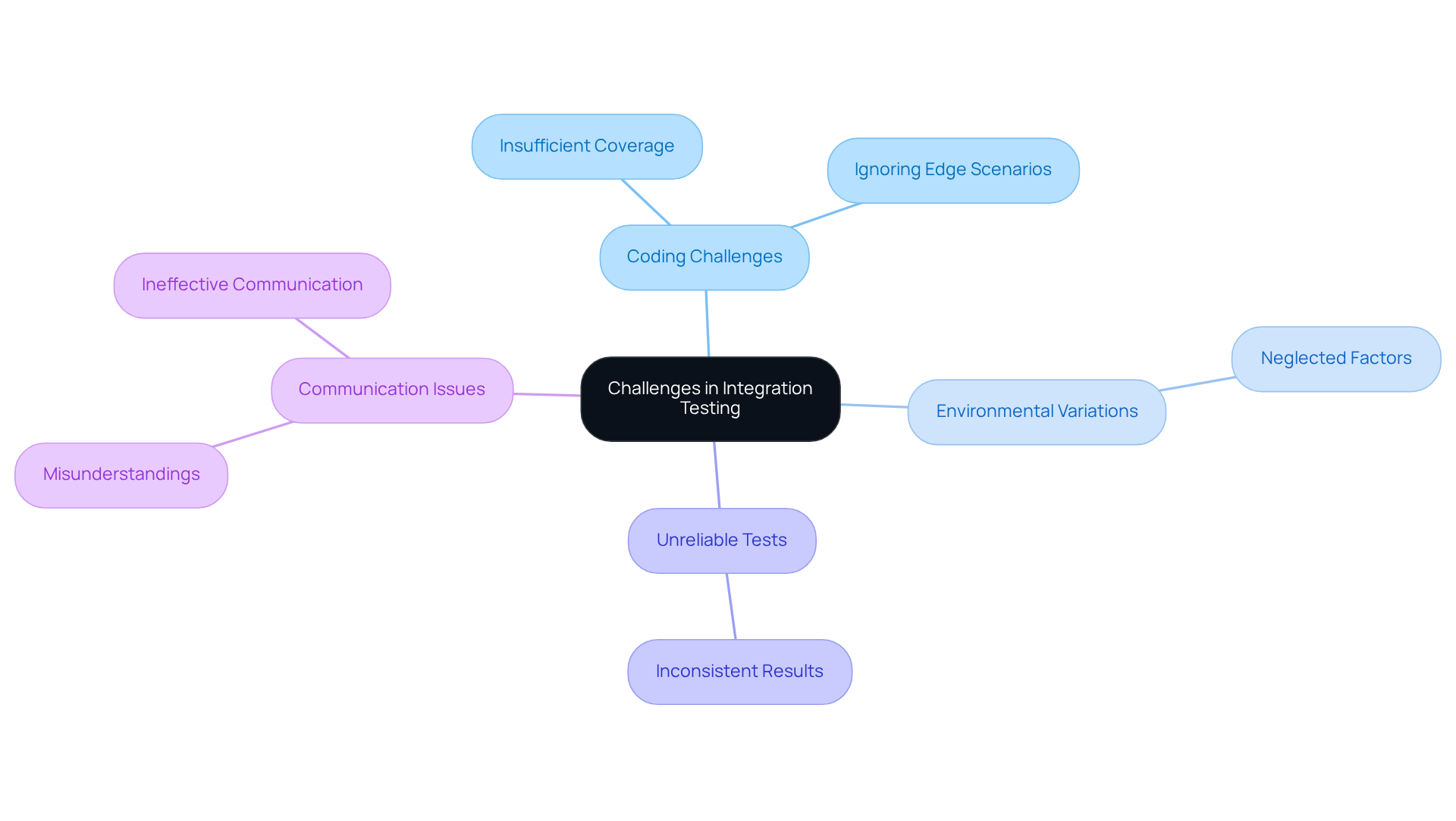
Integration Testing Strategies: Best Practices for Effective Implementation
To tackle the challenges of integration evaluation effectively, teams must prioritize several best practices. Have you ever considered how early evaluations in the development cycle can make a difference? Starting evaluations early is crucial, as it allows for the detection of issues before they escalate. Research indicates that only 9% of companies engage in fully automated evaluation, underscoring the importance of early defect detection and the need for a balanced approach to automation.
Involving cross-functional teams is another key strategy. Why? Because diverse perspectives can reveal potential integration issues that a single team might overlook. Furthermore, utilizing real-world data for evaluation scenarios enhances the relevance of assessments, making them more reflective of actual user experiences.
Automating evaluations wherever possible can significantly boost efficiency. Studies show that automation can reduce developers' feedback response time by up to 80%. In addition, regularly reviewing and updating test cases to align with changes in the codebase is essential for maintaining accuracy and relevance. This proactive approach not only improves software quality but also accelerates development cycles, enabling teams to deliver robust applications more efficiently.
As W. Edwards Deming wisely stated, "Quality is everyone's responsibility." This highlights the collective effort required to uphold high standards throughout the evaluation process. So, are you ready to embrace these best practices and elevate your integration evaluation strategy?
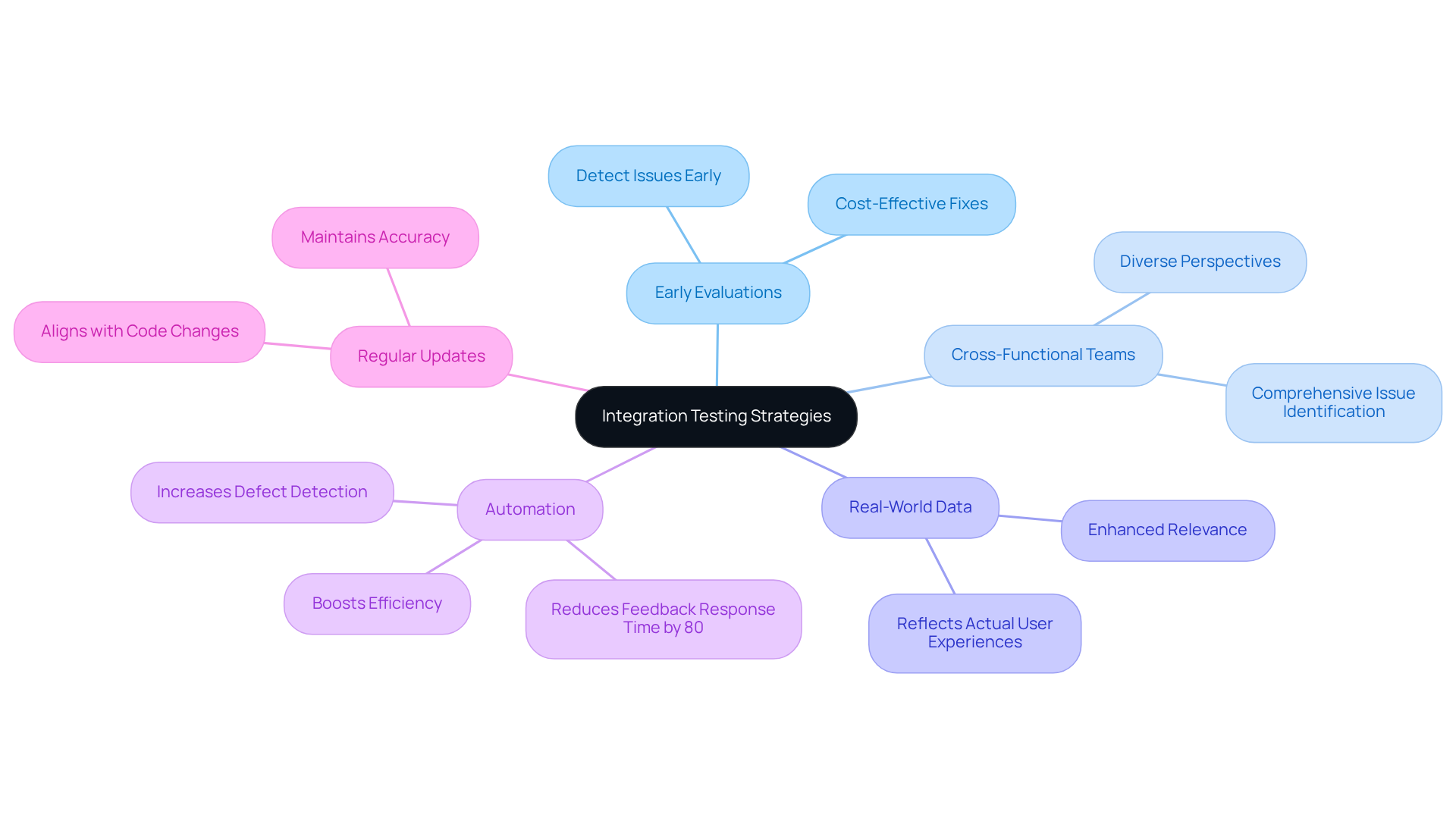
Automated Integration Testing: Enhancing Efficiency and Accuracy
Coding challenges can be daunting for developers, often leading to inefficiencies and errors. Automated system validation is a game-changer, enabling teams to conduct evaluations continuously and consistently. This results in significant improvements in efficiency and precision. By embedding AI code integration testing within CI/CD pipelines, every code change is validated against existing functionality. This proactive approach allows for the early detection of defects, which is crucial.
But how does Kodezi fit into this picture? Tools like Kodezi OS simplify the process of integrating evaluations into the development workflow. With Kodezi, organizations can streamline their CI/CD practices, leading to a reported 40% decrease in post-release defects. This highlights the effectiveness of combining automated validation with continuous integration and delivery.
Imagine the benefits: reduced costs associated with fixing bugs-since, as noted, the earlier a bug is found, the cheaper it is to fix-and enhanced overall software quality. Experts stress that incorporating AI code integration testing within CI/CD frameworks not only speeds up deployment but also fosters a culture of continuous improvement. This allows teams to react quickly to evolving requirements while maintaining high standards of software quality.
In addition, Kodezi promotes productivity and code quality, making it an essential tool for developers. Are you ready to explore the tools available on the platform? Discover how Kodezi can transform your coding practices and elevate your development process.
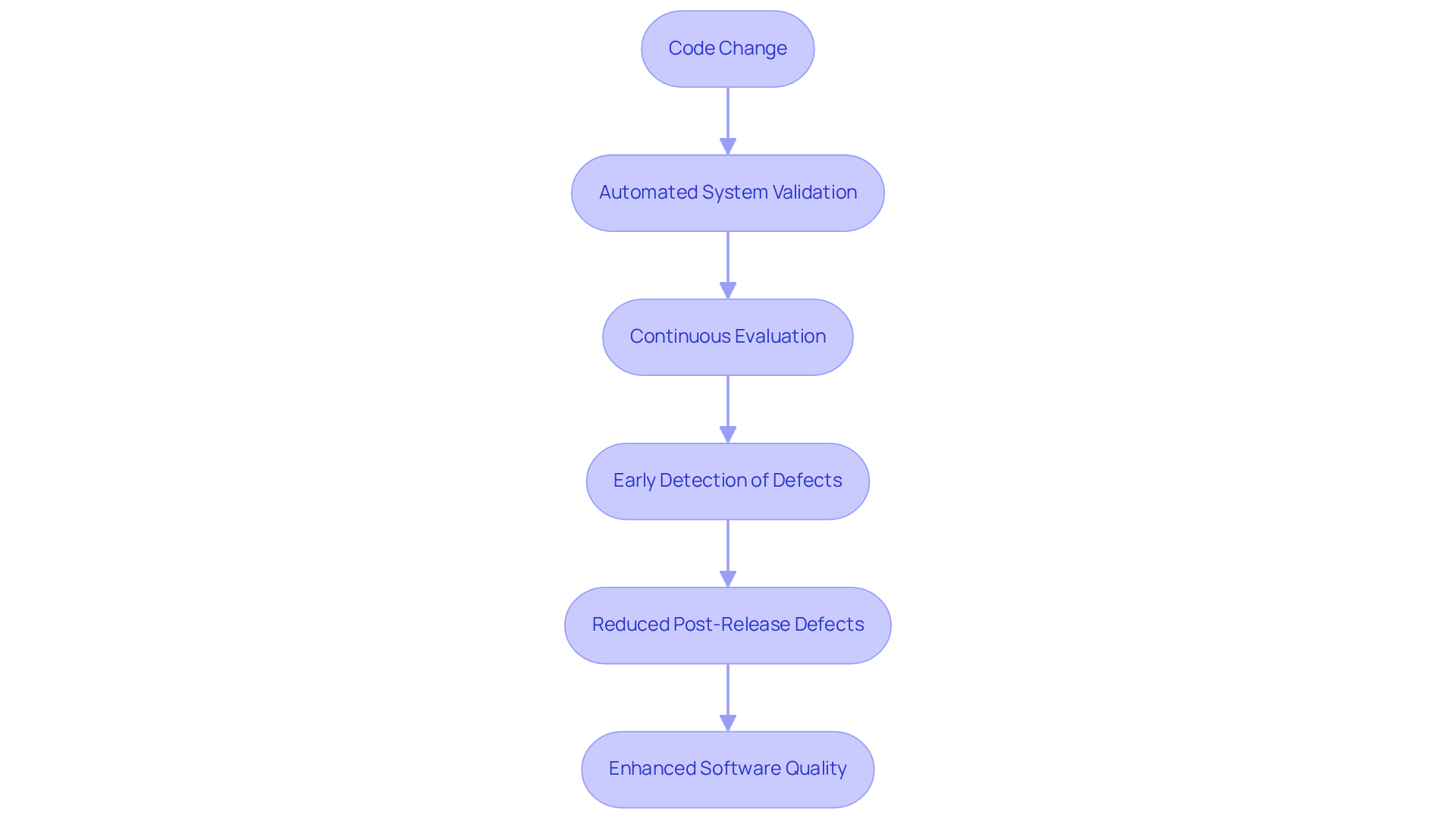
AI in Integration Testing: Transforming Code Quality Assurance
Coding challenges can be daunting for developers. With the increasing complexity of software projects, ensuring quality and efficiency is more critical than ever. This is where Kodezi steps in, transforming the landscape of AI code integration testing evaluation.
Kodezi addresses these challenges through AI code integration testing by facilitating intelligent test case generation, enhancing predictive defect detection, and automating the maintenance of test scripts. By leveraging historical data, Kodezi's tools identify patterns and suggest enhancements, leading to more efficient evaluation strategies. For instance, Kodezi CLI autonomously improves codebases and fixes bugs before they reach production, significantly boosting programming productivity.
The benefits of using Kodezi are clear. Not only does it enhance code quality, but it also allows teams to focus on more complex evaluation scenarios, ultimately increasing overall productivity. Organizations that have adopted AI code integration testing in their evaluation processes report a remarkable increase in defect detection accuracy, with some achieving up to a 75% improvement. Furthermore, the automation of test case creation enables a more flexible response to code modifications, ensuring that evaluation remains in sync with development cycles.
As the global AI in evaluation market is projected to reach $8.5 billion by 2027, the emphasis on predictive capabilities and automated solutions is becoming crucial for maintaining high standards in software quality assurance. Why not explore the tools available on the Kodezi platform and see how they can elevate your coding practices?

CI/CD Pipelines: Streamlining Integration Testing Processes
In today's fast-paced development environment, developers face significant challenges in maintaining high software quality. Incorporating evaluation procedures into CI/CD pipelines is essential for addressing issues related to ai code integration testing. By utilizing ai code integration testing within the pipeline, teams can verify every code change before deployment, which significantly decreases the risk of defects in production.
How does Kodezi help? Kodezi addresses these challenges by streamlining the evaluation process. Organizations adopting CI/CD practices have noted a 50% reduction in change failure rates and a 40% decrease in post-release defects. This showcases the effectiveness of ai code integration testing in enhancing software reliability. Furthermore, the continuous feedback loop facilitated by CI/CD pipelines and ai code integration testing enhances communication and collaboration among teams, leading to faster development cycles and improved software quality.
What are the benefits? By prioritizing ai code integration testing in evaluation, organizations can accelerate their release cycles and foster a culture of continuous improvement. This not only ensures high-quality software delivery but also boosts productivity. To get started with Kodezi CLI, check out the 5-minute quickstart guide and see a demo to experience how it can autonomously improve your code quality and fix bugs before they reach production.
Are you ready to tackle the challenges? Addressing difficulties in combining systems, such as inconsistent test environments and managing test data, is vital to fully achieving the advantages of automation. Explore the tools available on the Kodezi platform to enhance your coding practices and elevate your software quality.
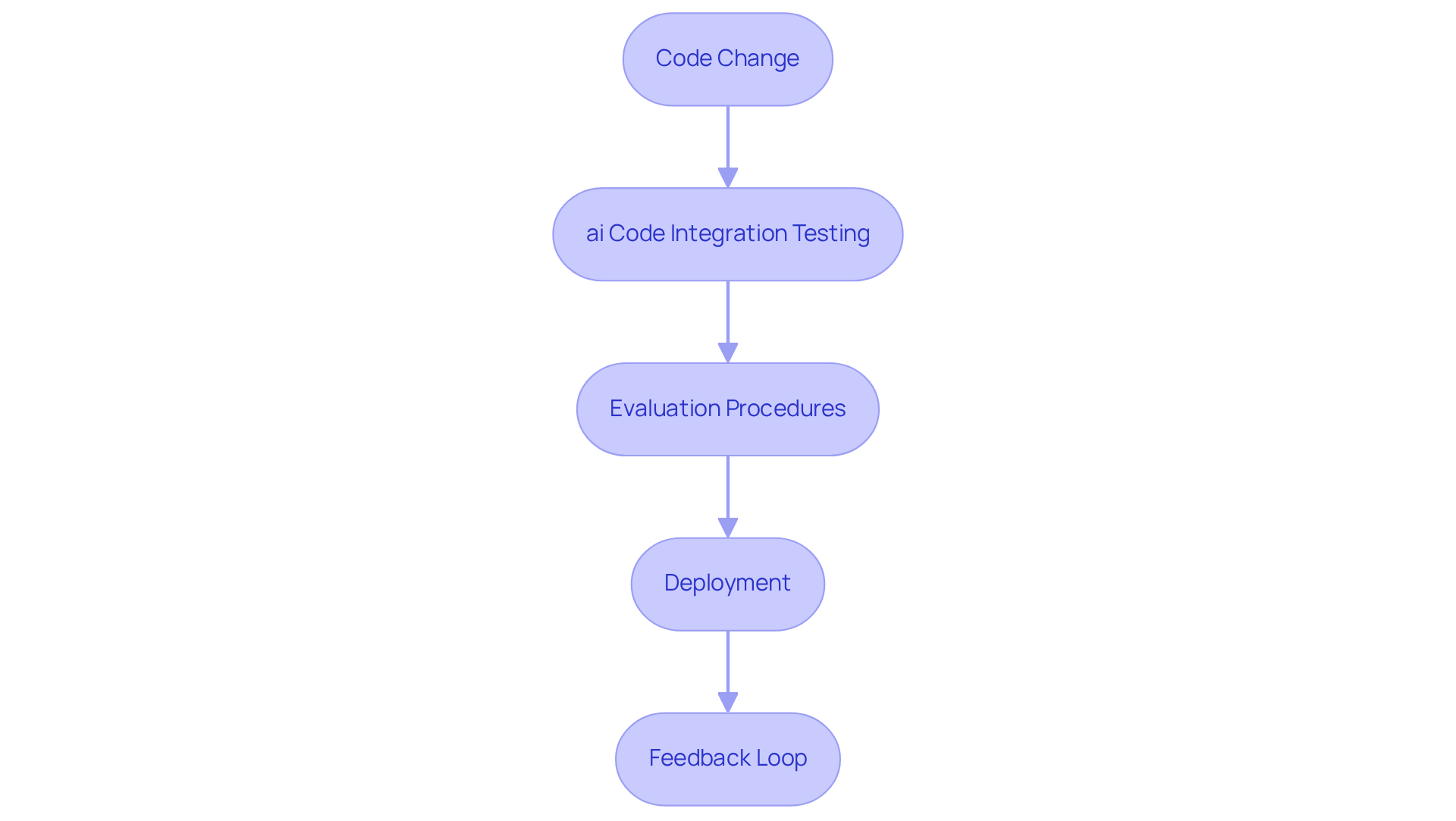
Cross-Functional Collaboration: Key to Successful Integration Testing
Effective combined verification hinges on robust cross-functional cooperation among developers, testers, and other stakeholders. Have you ever faced challenges in coding due to miscommunication? By fostering open communication and aligning on shared objectives, teams can comprehensively tackle all aspects of the integration process. Regular meetings and collaborative tools like Slack or Jira facilitate seamless interactions, bridging gaps between different roles. This approach not only enhances understanding but also promotes a cohesive evaluation strategy, ultimately leading to improved outcomes.
Consider how incorporating agile methodologies like Scrum can streamline communication. It ensures that all team members are on the same page and can quickly address any issues that arise. Furthermore, establishing clear communication protocols and encouraging feedback can significantly enhance the effectiveness of integration evaluation. This allows for early identification of potential issues and fosters a culture of continuous improvement.
As Helen Keller wisely noted, 'Alone we can do so little; together we can do so much.' To further enhance collaboration, think about implementing regular check-ins using collaborative tools like Slack or Jira. This maintains open lines of communication and strengthens team dynamics.
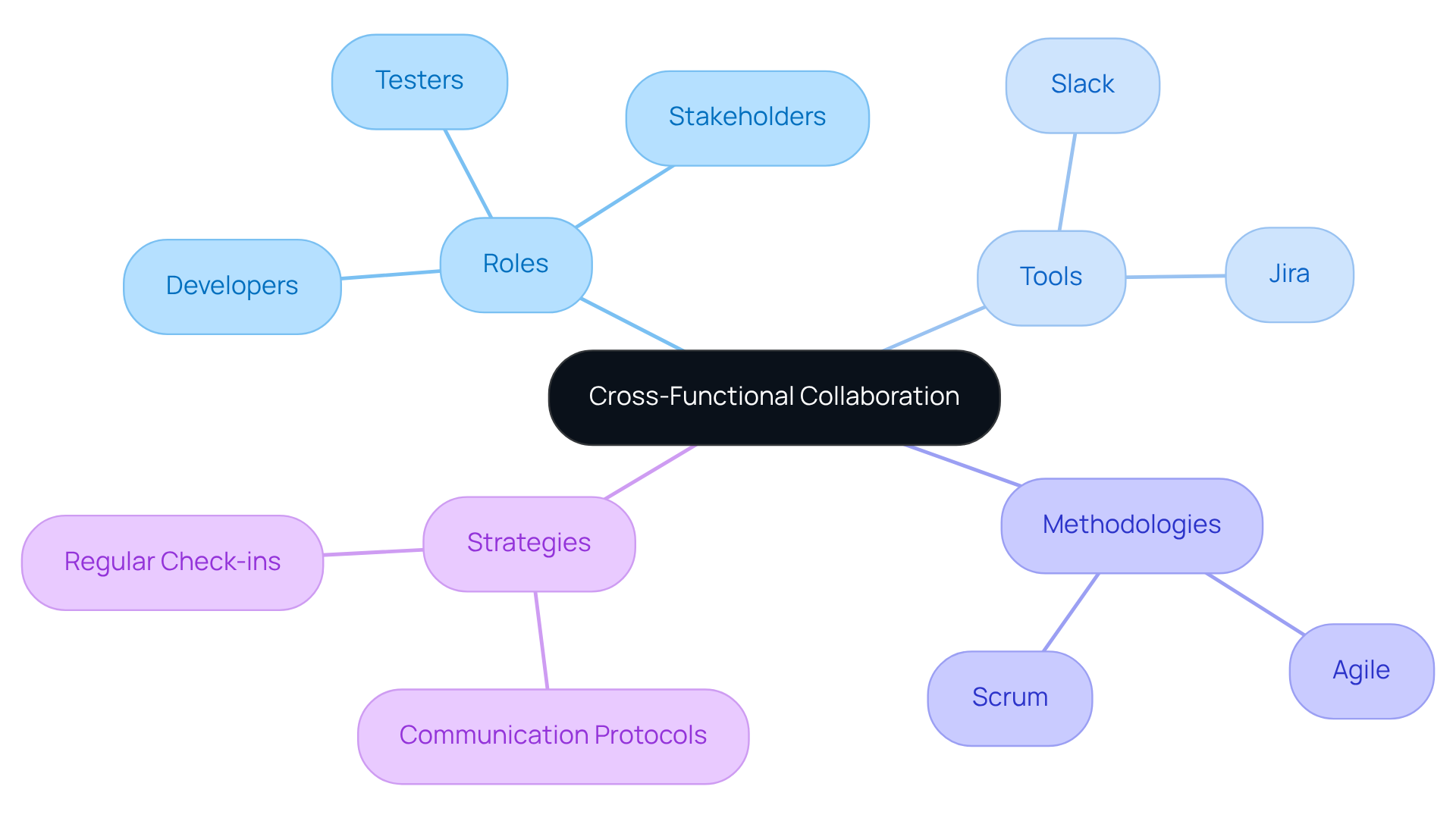
Integration Testing and Security: Safeguarding Your Codebase
Coding can be a challenging endeavor for developers, especially when it comes to ensuring the security and quality of their code. AI code integration testing plays a crucial role in safeguarding your codebase by uncovering potential security vulnerabilities that may arise during component interactions. By implementing security-focused evaluation strategies like threat modeling and penetration assessments, teams can proactively identify weaknesses before they can be exploited.
How does Kodezi fit into this picture? This AI-powered programming tool automatically analyzes bugs and corrects code, functioning like an autocorrect feature for programming. With Kodezi, developers can enhance code quality while simultaneously recognizing and addressing vulnerabilities during the merging process. Furthermore, Kodezi optimizes code and generates comments, allowing developers to focus on security measures without getting bogged down by manual debugging tasks.
The benefits of prioritizing security within the evaluation process are significant. Not only does AI code integration testing enhance overall risk management, but it also protects sensitive data, fostering a more resilient development environment. Investing in robust consolidation evaluation methods is essential for maintaining trust and compliance in today’s digital landscape.
Key Features of Kodezi:
- Automatic Bug Analysis: Quickly identifies and corrects coding errors.
- Vulnerability Recognition: Helps developers spot security issues during integration.
- Code Optimization: Improves overall code efficiency and readability.
- Comment Generation: Saves time by automatically creating documentation.
In conclusion, Kodezi not only addresses common coding challenges but also empowers developers to enhance their productivity and code quality. Are you ready to explore the tools available on the platform and elevate your coding practices?
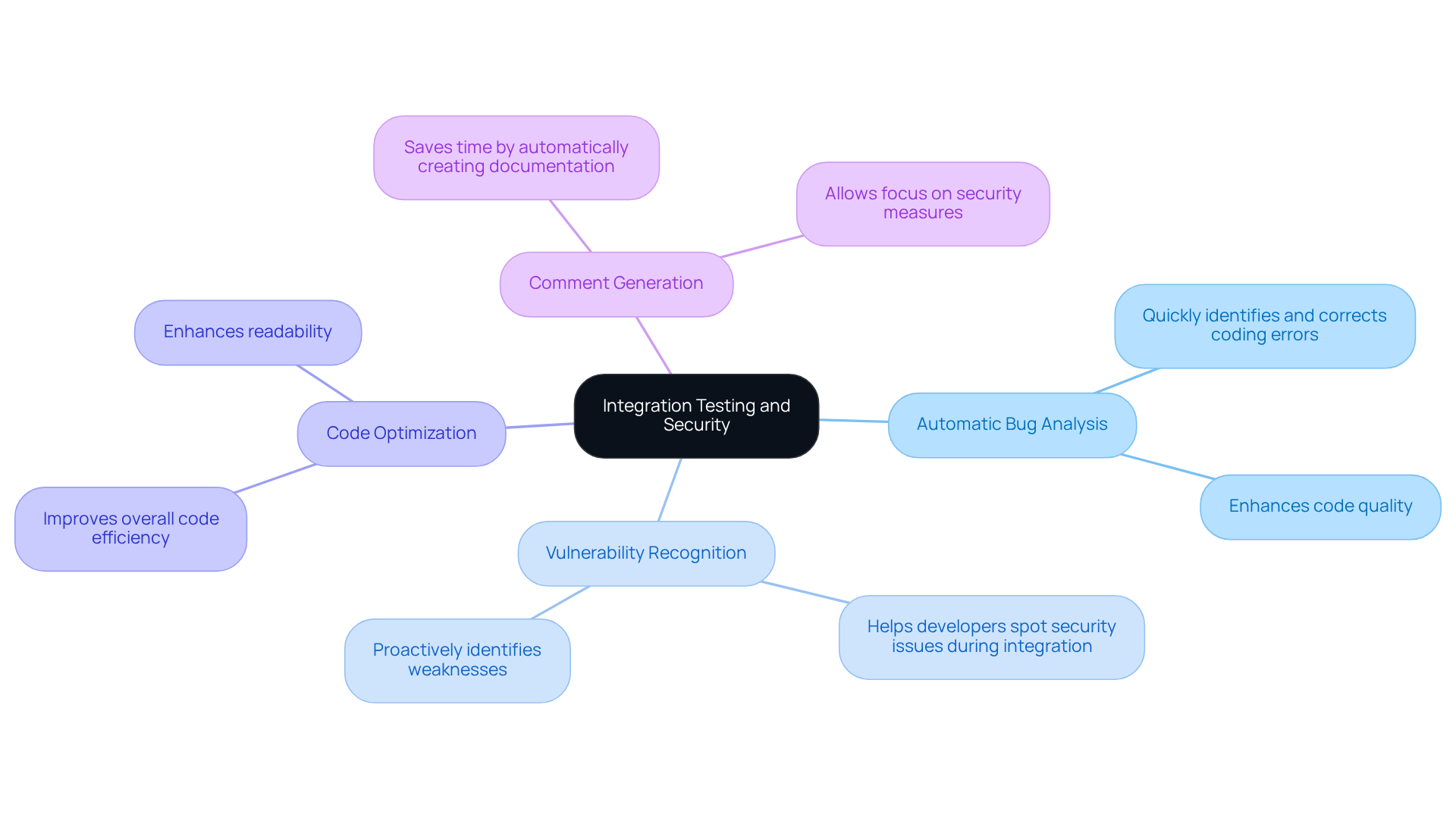
Future Trends in Integration Testing: What to Expect
The landscape of integration evaluation is evolving rapidly, driven by significant advancements in AI and automation technologies. Have you noticed how organizations are increasingly adopting AI-driven evaluation tools? In fact, 42% of large companies are actively deploying AI in their assessment workflows. This shift is set to enhance precision and productivity, as AI tools automate repetitive tasks, allowing teams to focus on more complex evaluation scenarios.
Furthermore, as companies embrace microservices architecture, the demand for advanced integration assessment strategies becomes crucial. These strategies ensure seamless interactions between distributed components, effectively addressing the complexities that arise from this architectural shift.
Security and compliance are also becoming paramount in future evaluation practices. With 85% of organizations recognizing the importance of cloud-based automation solutions, there’s a growing emphasis on integrating security measures into the evaluation lifecycle. This proactive approach is vital for businesses aiming to mitigate risks associated with vulnerabilities in their applications.
Expert opinions highlight the transformative potential of AI in testing. For instance, 39% of groups report efficiency improvements from AI-powered automation, showcasing its role as a 'co-pilot' that enhances human capabilities rather than replacing them. Moreover, 60% of organizations utilizing automation see significant improvements in application quality, underscoring the benefits of AI integration. However, challenges remain, with 26% of teams struggling to choose the right test automation tools. As organizations navigate these changes, implementing AI code integration testing will not only streamline processes but also cultivate a culture of continuous improvement and innovation in software development.
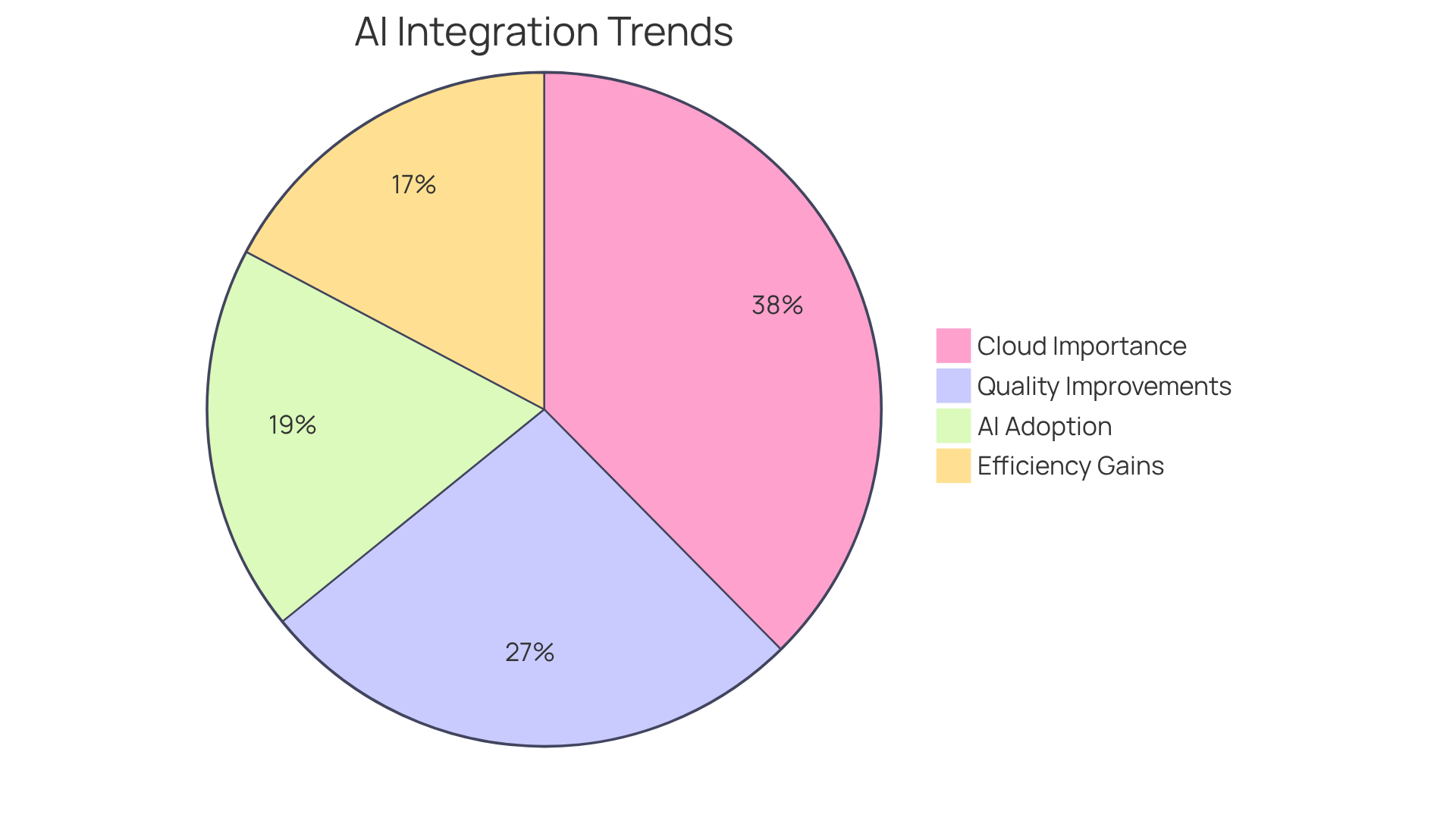
Conclusion
In today’s fast-paced software development landscape, the challenges developers face are more complex than ever. With the increasing intricacies of APIs and the need for seamless connectivity, tools like Kodezi become essential allies in boosting productivity and ensuring top-notch code quality. By automating critical processes and offering robust evaluation frameworks, Kodezi enables teams to tackle integration testing challenges with confidence.
Furthermore, this exploration has underscored key strategies such as:
- Early evaluations
- Cross-functional collaboration
- The integration of automated testing within CI/CD pipelines
These practices not only help teams identify and resolve issues swiftly but also cultivate a culture of continuous improvement and innovation. The significant advantages of adopting AI-driven tools - like enhanced accuracy and lower defect rates - demonstrate the powerful impact of integrating these technologies into development workflows.
As integration testing continues to evolve, embracing AI and automation is vital for organizations looking to stay ahead of the competition. By prioritizing effective evaluation strategies and utilizing platforms like Kodezi, teams can streamline their processes while significantly boosting code quality and security. The future of integration testing is in the hands of those ready to adapt and innovate - are you prepared to revolutionize your coding practices?
Frequently Asked Questions
What is Kodezi and what does it do?
Kodezi is a professional OpenAPI specification generator that automates code connectivity evaluation, helping B2B engineering teams ensure seamless API integration and accurate documentation.
How does Kodezi enhance programming productivity?
Kodezi enhances programming productivity by automating AI code integration testing, which simplifies the process of generating and maintaining API documentation and aligns it with the latest code changes, reducing the risk of human error.
What is the projected market size for automation evaluation by 2025?
The automation evaluation market is projected to reach $68 billion by 2025, highlighting the growing importance of tools like Kodezi.
What are the core objectives of integration testing?
The core objectives of integration testing include identifying interface defects, validating data flow between modules, and ensuring that all components operate correctly within a unified environment.
Why is early detection of issues important in integration testing?
Early detection of issues is important because it can significantly reduce the cost and complexity of addressing problems later in the development cycle, with studies indicating potential cost savings of up to 24%.
How can automated assessment procedures impact efficiency?
Companies that implement automated assessment procedures have reported a 30% boost in efficiency, demonstrating the positive impact of strong evaluation practices on development workflows.
What common challenges do developers face in integration testing?
Common challenges include insufficient coverage of assessments, ignoring edge scenarios, environmental variations, unreliable tests, and ineffective communication among team members.
How does Kodezi address challenges in integration testing?
Kodezi provides specific features designed to tackle coding challenges, enhance productivity, and improve code quality, fostering a collaborative environment that minimizes errors and maximizes efficiency.




